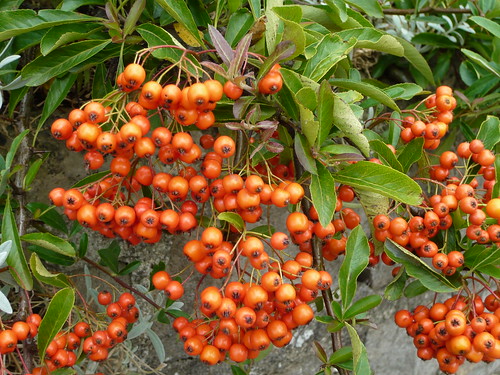Firethorn or Pyracantha For Berries
Pyracantha, can be a neat shrub with attractive flowers and magnificent red, yellow or orange berries. The white flowers in summer are followed by autumn and winter berries, in fact my shrubs are still in berry this March.
Growing Tips
- Train your Pyracantha against a wall or fence or as a specimen plant.
- Clipped regularly Firethorn, or Pyracantha as it is correctly known, also makes an excellent evergreen hedge.
- Plants will grow in most fertile garden soil in sun or partial shade.
- Avoid water-logging but if near a wall or hedge water your plants in dry spells.
- Berrying may be reduced in shady sites or against north-facing walls.
- Plants grow 5-10 feet high and wide if unrestricted.
- A general purpose spring feed and mulch is welcome.
- Propagate from cuttings or seed that may not come true to the parent plant.
Pruning and Clipping
- Pyracantha flowers on shoots produced the previous year so avoid trimming off too many flowers. Try to retain as much two-year-old wood as possible.
- Pyracantha has long, sharp thorns hence it’s common name Firethorn. It can be used in a hedge to deter unwanted visitors
- When overgrown, Pyracantha can be heavily pruned to get back into shape.
- Prune to make the berries more visible and to keep the plants in shape.
- Shorten all sideshoots that grow from the main framework in late summer. Stop just short of the clusters of berries  about two to three leaves from the base of the side shoot.
- While young shoots are still flexible so tie them in or train to form shapes.
- Trim Pyracantha hedges a couple of times between spring and the end of summer
RHS recommended varieties
- Pyracantha ‘Orange Glow’ AGM: Purple-black stems, orange-red fruits, .
- Pyracantha rogersiana AGM: Orange-red fruits, good for shaded walls.
- Pyracantha ‘Flava’ AGM: Yellow fruits, weeping habit.
Pyracantha are good shrub for a wildlife garden, providing dense cover for roosting and nesting birds, summer flowers for bees. They also produce an abundance of berries as a food source. More pictures
